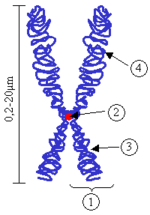Chromatid

(1) Chromatid. One of the two identical copies of the chromosome after S phase.
(2) Centromere. The point where the two chromatids touch, and where the microtubules attach.
(3) Short arm
(4) Long arm.
A chromatid is one of two identical copies of DNA making up a chromosome that are joined at their centromeres, for the process of nuclear division (mitosis or meiosis). The term is used so long as the centromeres remain in contact. When they separate (during anaphase of mitosis and anaphase 2 of meiosis), the strands are called daughter-chromosomes. The tips of the chromatid are called telomeres. They are there to prevent the ends of the chromosome from attaching to other chromosomes. It has been said that after repeated cell replication, the telomeres get shorter resulting in cell death. This means that the way telomeres work could determine the lifespan of a cell. However this has not been proven.[1]
In other words, a chromatid is "one-half of a replicated chromosome".[2] It should not be confused with the ploidy of an organism, which is the number of homologous versions of a chromosome.
Quantity
In humans, for example, there are normally 23 pairs of chromosomes in each cell. N=23. However, the quantity of chromatids is various 46. It can be either 4N, 2N or 1N. The latter is only seen in haploid gametes, with only one of each homologous chromosome pair. Such are created in gametogenesis.
4N
In a cell with 4N chromatids, there are 23 chromosome pairs (46 chromosomes), and each chromosome has 2 chromatids. Thus, there are 92 chromatids in each cell (4xN) which occurs during anaphase 2 of meiosis.
2N
Immediately after a mitosis, where a cell has divided in two, but not yet duplicated its DNA, there are still 23 chromosome pairs (46 chromosomes). However, each chromosome only has one chromatid. Thus there are 46 chromatids (2xN)
Alternatively, a haploid cell with two chromatids per chromosome also has 46 chromatids. However, this doesn't occur naturally in humans.
1N
Immediately after meiosis, each cell, called a gamete, only has half the amount of chromosomes (23 chromosomes). Furthermore, each chromosome only has one chromatid. Thus, there are 23 chromatids (1xN)
Etymology
The term chromatid was proposed by McClung (1900) for each of the four threads making up a chromosome-pair during meiosis. It was later used also for mitosis.
The term derives from the Greek chroma (colour); for the derivation of -id, see diploid.
References
ca:Cromàtida de:Chromatid it:Cromatidio he:כרומטידה ku:Kromatîd nl:Chromatide sr:Хроматида sv:Kromatid